The RoadPro Guide to Lead-acid Leisure Batteries
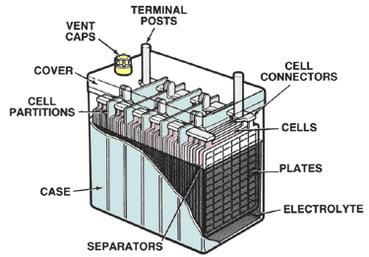
The Basics
Although lead-acid batteries have been around since 1859 when they were invented by M. Gaston Planté, they are similar now to how they were then. They look quite simple but the physics and chemistry involved is very complex indeed and the conditions in which they’re used affect their performance as well. For example, temperature affects a battery’s performance hugely and batteries last far longer in Iceland than they do in Saudi Arabia. Different manufacturers use different materials in their batteries which changes the way they work.
And, we really don’t have the time or space to go into Peukert’s Law other than to say batteries last longer and give more energy overall if you use them gently. So, treat this as an informative but far from exhaustive guide to leisure batteries.
All lead-acid batteries are made with similar raw materials including: lead, tin, other metals, lead oxide, sulphuric acid and water. It’s the way that these materials are combined that makes them more or less suitable for particular applications. There are basically two kinds of lead-acid battery in common use: ones which are designed to start engines and others which are intended for powering motors or equipment of one sort or another. These are known as deep-cycle or traction batteries.
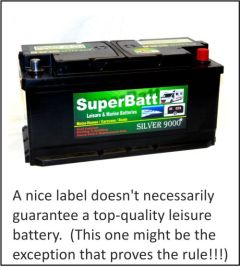
A leisure battery isn’t a particular type of battery: it’s just what someone decided to call the battery that is used in caravans, motorhomes and boats to power the 12V equipment on board. In other parts of the world they’re known as “domestic batteries”, “house batteries”, “auxiliary batteries” and “service batteries”.
Caravan and motorhome dealers, chandlers and other retail outlets usually sell a variety of these batteries, often with images of caravans, motorhomes and boats on the label and with vivid descriptions such as “High Power”, “Deep Cycle”,” “Multi-Purpose”, etc. But, however a battery is described and whatever it says on the label, the fact of the matter is that a battery is either designed to be a starter battery OR a deep-cycle battery of some sort or another: it can’t be both. The reality is that almost all batteries which claim to be “leisure” batteries are actually starter batteries with a fancy label.
1) Starter batteries are designed and built so that they can release large amounts of energy for just a few seconds – when turning over an engine. They have thin plates which can release and absorb energy quickly and, because they are usually charged up as soon as energy has been taken out, they require very little maintenance and can last for many years. Starter batteries are not designed to be able to withstand deep discharge and this makes them unsuitable for use as leisure batteries when frequent deep discharge is going to occur.*
2) As explained above, most so-called leisure batteries are starter batteries with a caravan, a motorhome or a boat on their labels. True leisure batteries are really deep cycle or traction batteries and have thick plates which enable them to cope with the demands of high current draw and frequent, prolonged discharging. They’re designed to operate motors on machinery, fork-lift trucks, etc: even submarines! This makes them ideal for use as leisure batteries. Because deep cycle batteries are usually subjected to much more stress than starter batteries, they may not last as long but their useful life is entirely dependent on exactly how they’re used and maintained.
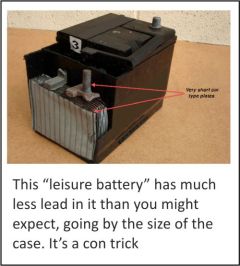
A simple way to tell whether a battery is what it claims to be or is just – let’s not mince words – a con trick is to weigh it. Lead is heavy but the more lead in a battery, the better the battery is likely to perform when used as for operating applainces. We weighed one of the most popular 110Ah leisure batteries – with a well-known name, an attractive label and lots of advertising support – and found that it weighed in at 5Kgs less than another 110Ah battery which is specifically designed to be used as a leisure battery. This difference in weight can mean a significant difference in performance and life expectancy.
* Having said that, for many people, a starter battery can be just what they need as a leisure battery. If you have a caravan or a motorhome and you always use campsites with mains hook-up or if you have a boat and always moor in a marina, you can probably get good service out of the cheapest starter battery you can find. The battery isn’t being called on to provide serious amounts of electricity but is simply a buffer for the on-board 230V-12V power supply. If, on the other hand, you want to be self-reliant and be able to operate your appliances reliably when off-grid, a starter battery – even if it’s dressed up as a leisure battery – is not suitable and may not give you the kind of performance or reliability that you need. It all depends on how you use your battery.
What about "maintenance-free" batteries?
It’s natural to think that a “maintenance-free” battery is exactly what it says on the box and it is as long as it’s never charged at more than 14.1V which is the point at which a battery starts to gas at 25˚C. (The voltage at which batteries gas changes according to the ambient temperature.) This makes them suitable for use as starter batteries but not for leisure use where the battery is subjected to frequent heavy discharging and charging. If the vehicle or boat is always connected to a mains electricity supply, a “maintenance-free” battery can be ideal but, if you want to discharge the battery and then charge it again quickly on a regular basis, they’re just not suitable. (Having said that, gel and AGM batteries are maintenance-free and can be very suitable indeed for use as a leisure battery.)
What are the different types of leisure battery?
As well as being classed as starter or deep cycle, lead-acid batteries can be divided into three other categories: wet, gel and AGM (absorbent glass mat). There are even different types of battery within these groups. Each has advantages and disadvantages.
Wet lead-acid batteries are usually the cheapest to buy but, when actively used as leisure batteries, will need regular maintenance. This is because some of the water in the electrolyte is split into its component parts of hydrogen and oxygen gas during the charging process and released into the atmosphere. This is gassing. If the electrolyte isn’t topped up (with distilled water), the battery will be damaged and stop working as it should. As mentioned above, unless you spend all your time with mains hook-up, avoid “maintenance-free” batteries.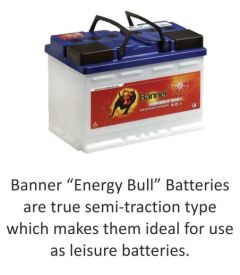
Main features of wet lead-acid batteries:
- Can be charged quickly at high charge rate.
- Expected number of cycles* of 200+ at 50% discharge. This will vary hugely depending on how the battery is charged and discharged and whether it’s a “normal” leisure battery (i.e. really a starter battery) or a real traction or semi-traction battery.
- Require regular checking and maintenance which varies according to the design of the battery.
- Comparatively high rate of self-discharge.
- Can be damaged by vibration and shock.
- Performance will be greatly affected by ambient temperature.
- The least expensive type of battery.
*Cycling is the process of discharging and charging a battery.
- AGM stands for Absorbent Glass Mat and this describes the way the electrolyte is stored inside the battery: absorbed in mats of glass fibre. This method of construction has several advantages over wet batteries including greater resistance to shock and vibration, greater depth of discharge, lower self-discharge and faster charging times (because they can absorb higher current than wet batteries). Like gel batteries they can be mounted in any position (except upside down) and they are maintenance free.
Main features of AGM lead-acid batteries:
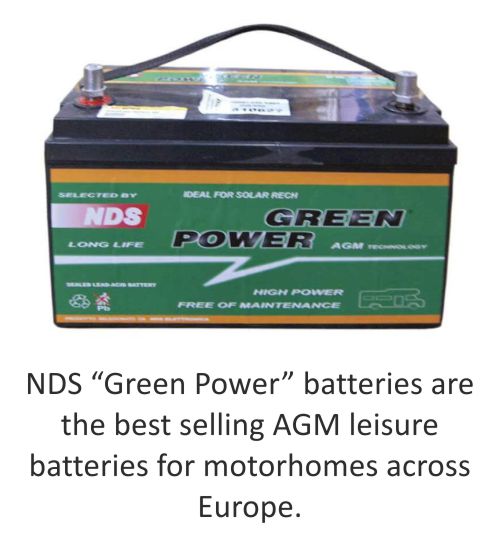
- Expected cycle life of 500+ at 50% discharge. This can be a lot higher for real, specially designed traction batteries.
- Better performance (than wet batteries) in high and low ambient temperatures.
- Can discharge at higher rates than gel.
- Lower rate of self-discharge.
- Maintenance free.
- Do not gas or give off potentially dangerous fumes.
- Do not deteriorate as quickly (compared to wet batteries) when left in a discharged state.
- Can be positioned on their side.
- Good resistance to vibration and shock.
- Sensitive to overcharging and must be charged according to the manufacturers’ instructions. The maximum charging voltage is usually 14.7V.
- AGM batteries have many of the advantages of gel batteries but are usually cheaper.
- More expensive than wet lead-acid batteries but cheaper than gel.
- Gel batteries are the most expensive type of lead-acid battery. The liquid electrolyte is replaced by a gel which makes them a lot safer in case of an accident where the battery casing is damaged. They can also be installed in places where a wet battery can’t (because they don’t gas when charged correctly) and they can be mounted in any position, although upside down is not recommended. In addition, they are truly maintenance-free and, if used according to the manufacturer’s instructions, they can last for many years. However, their performance is no better than that of a wet lead-acid battery and they can be easily damaged if charged at too high a voltage. Gel batteries are most suitable for applications where very deep discharge is required as they can usually survive this kind of treatment better than other lead-acid batteries. They also tend to perform better in high ambient temperatures and they can withstand vibration and shock.
Main features of gel lead-acid batteries:
- Expected cycle life of 500+ at 50% discharge.
- Better performance (than wet batteries) in high and low ambient temperatures.
- Maintenance free.
- Do not gas.
- Do not deteriorate as quickly (compared to wet batteries) when left in a discharged state.
- Can be positioned on their side.
- Good resistance to vibration and shock.
- Expected cycle life of
- More expensive than wet lead-acid batteries and AGM batteries.
Both AGM and gel batteries last longer because the lead paste is physically retained on the plates by the GEL or by pressure of the glass mat. This helps to prevent the paste dropping off the plates’ surfaces as it does with wet electrolyte batteries.
OK, we know that this guide is about lead-acid leisure batteries, but.............
Lithium batteries are more expensive than lead-acid batteries but their advantages make them ideal for use as leisure batteries. In short, they don’t have 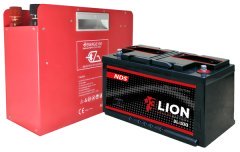 any of the disadvantages of other batteries such as slow charging, regular maintenance, sulphation and heavy weight. There are different types of lithium battery but the ones that are most suited to use in vehicles and boats as a replacement for a 12 volt lead acid battery are LiFePO4 models. A LiFePO4 battery will have just four series connected cells to make 12 volts. In practice each cell is lots of parallel connected smaller cells. LiFeP04 batteries include a battery management system (BMS) to ensure that the cells correctly share the charging and discharge currents and are neither over charged nor over discharged. Other lithium ion technologies, such as that used in electric bicycles have a different cell voltage and cannot be connected to provide a nominal 12 volt supply.
any of the disadvantages of other batteries such as slow charging, regular maintenance, sulphation and heavy weight. There are different types of lithium battery but the ones that are most suited to use in vehicles and boats as a replacement for a 12 volt lead acid battery are LiFePO4 models. A LiFePO4 battery will have just four series connected cells to make 12 volts. In practice each cell is lots of parallel connected smaller cells. LiFeP04 batteries include a battery management system (BMS) to ensure that the cells correctly share the charging and discharge currents and are neither over charged nor over discharged. Other lithium ion technologies, such as that used in electric bicycles have a different cell voltage and cannot be connected to provide a nominal 12 volt supply.
Lithium LiFePO4 batteries are very safe and have excellent performance. Here are some of their features
- Expected cycle life of 2,000+ at 75% discharge.
- Much lighter than lead-acid batteries.
- Can be charged quickly at high charge rate.
- Can be discharged to below 10% of capacity.
- Do not gas or give off potentially dangerous fumes.
- Do not seriously deteriorate when left in a discharged state.
- Very low self-discharge rate
- Maintenance free although regular checks are recommended.
- More expensive than lead-acid batteries
PLEASE NOTE: These specifications for cycle life and discharge should be regarded only as a rough guide. Actual cycle life and overall performance will vary according to the conditions in which a battery is used, how it is used and how it is maintained. Published cycle life figures using the same test criteria are a good way to compare one battery with another.
RoadPro stocks Energy Bull (semi-traction) wet lead-acid batteries from Banner, Green Power AGM batteries from NDS and lithium batteries from EZA, NDS and Super B.
So what sort of battery is best for leisure use?
There’s no such thing as the best battery for every situation. Depending on what you want to achieve, a small, cheap starter battery may be best. For someone else, only a couple (or more) of high-capacity AGMs or gel batteries will do. People who rely on their batteries and try to avoid mains hook-up may find that only a lithium battery will provide the energy they need within the weight carrying limits of their vehicle. If in doubt, consult RoadPro or a good auto-electrician.
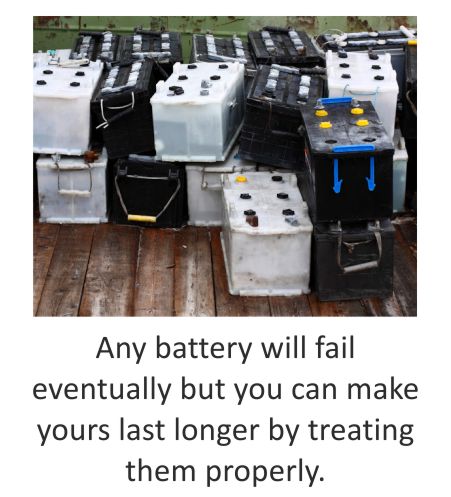
What’s the best battery to use with a motor mover?
A motor mover is exactly the kind of equipment that a semi-traction battery is designed for. Motor movers need a high current for a period of time – not just for starting an engine. The most suitable battery will depend on how often a motor mover is used, the period of time that it’s used for and how it’s charged up after use. Unless you’re only using it infrequently and for just a few seconds though, this is the kind of application where paying more for a good battery will definitely pay dividends.
What causes batteries to fail?
Batteries are a bit like tyres: how long they last depends entirely on how they’re used. A new set of tyres on a car can last for many years if kept correctly inflated and used infrequently and carefully. On the other hand, drive into kerbs at speed or perform donuts and handbrake turns and tyres can be destroyed in a matter of hours. However, even the best tyres when used considerately will eventually wear out and it’s the same with batteries: they don’t last for ever. Here are the most common causes of premature battery failure.
- Insufficient Electrolyte: When charged at a voltage higher than 14.4V (depending on the ambient temperature), a wet lead-acid battery will gas prolifically and electrolyte will dissipate as hydrogen and oxygen. If it’s not replaced (using distilled water), the exposed parts of the plates will rapidly sulphate. This reduces the battery's ability to accept a charge. When electrolyte dissipates, another result can be increased erosion of the plates due to the higher concentration of acid. Finally, internal resistance increases when the electrolyte level is low: high resistance causes heat which, again, will damage the battery.
- Sulphation: Any lead-acid battery will naturally develop sulphate on its plates during its lifetime. It’s caused when the electrolyte begins to break down, allowing crystals to form. But excessive sulphation happens when the battery’s voltage drops to below 12.4V and the battery is allowed to remain discharged for a period of time. This can be months, weeks or even days, depending on the type of battery, its state of charge, its temperature and its general condition. To minimize sulphation, don’t leave a battery discharged for more than 24 hours. If a battery is sulphated, use of a charger with a desulphation mode will help remove the sulphate from the plates. Sulphation of batteries starts when the specific gravity of the electrolyte falls below 1.225 or the Voltage is less than 12.4V. Sulphation will reduce the battery’s ability to function as it should. There are devices for removing sulphation but it’s much better to prevent it happening in the first place with proper battery care and maintenance. Sulphation is the most common reason for lead acid batteries failing prematurely.
- Overheating: Batteries don’t work well when they’re hot. If they get very hot – over 50˚C – the chemical reaction increases, plates can buckle and the battery can be destroyed.
- Freezing: If the electrolyte freezes and turns to ice, the active material on the plates will be dislodged. In really
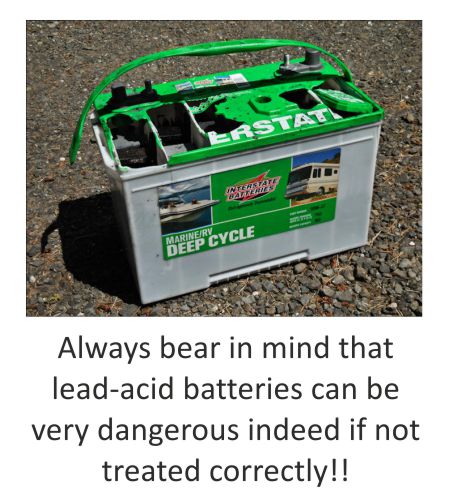 severe cases, the case may crack allowing electrolyte to escape when it thaws.
severe cases, the case may crack allowing electrolyte to escape when it thaws. - Vibration: If a battery isn’t installed securely, shock and vibration can dislodge the active material from the plates and reduce battery life. AGM and gel batteries are not as affected by vibration as are wet batteries. Connections should always be checked regularly if batteries are subjected to high vibration.
- Overcharging: There’s one thing worse than undercharging a battery and that’s overcharging. This quickly causes the water to dissipate as gas, lowering the level of the electrolyte and increasing the concentration of the acid. The result is corrosion of the plates. Excessive heat can be generated which, in a process called thermal runaway, can cause the plates to buckle. In addition, in really severe cases, the battery’s case can bulge and, in the worst cases, explode. Overcharging your batteries is a very bad idea indeed.
Correct charging is the key to long battery life and maximum performance. The most important thing to understand about recharging lead-acid batteries is that charging them at a constant voltage will not fully charge or maintain them. This is how cheap chargers work and, although they’re usually suitable for starter batteries (though not ideal), using them on leisure batteries is a false economy. At best, the battery’s life and performance will be reduced and, at worst, the battery can be damaged and stop working altogether.
Correct charging and maintenance requires an intelligent charging system that can vary the voltage, the current and the length of time a high charging voltage phase is applied. Battery temperature is also monitored with higher power chargers. Chargers that operate like this are often referred to as “smart” or “intelligent” chargers and, while more expensive than basic chargers, can pay for themselves in the long run.
A smart charger puts energy back into a battery in stages. The number of stages varies according to the charger but some CTEK units have as many as eight stages. At each stage, the voltage and current will be put into the battery according to the battery’s requirements, ensuring a safe and effective charge. There are three main stages: bulk, absorption & float. Bulk takes the battery up to 80% of its capacity and the absorption phase is used for the remaining 20%. During the float stage, both the charge voltage and current are reduced and held constant. This mode is used to keep the battery fully charged. A good charger has settings for wet, AGM and gel batteries as well as, in some cases, lithium, all of which require different charging voltages to ensure maximum performance and cycle life.
There are European standards for specifying a charging regime and these are often identified by letters in the charger documentation. E.g. IUoU is a DIN-designation (DIN 41773) for a lead-acid battery charging procedure that is also known as 3-stage charging. This translates as I Constant current, U voltage limit 1, o the small current at which the charge voltage is reduced to, U the lower maintaining voltage limit 2. Modern smart chargers frequently have more phases of charge than this and also time limit the high voltage charging phase. 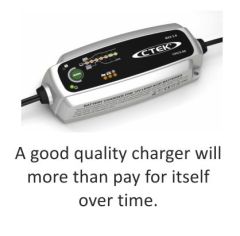
A charger that has multiple stages uses clever electronics to provide de-sulphation, reconditioning, soft start and analysis modes. These can all help to make the charger more efficient. The more modes the better!
Battery chargers are rated according to the maximum current that they can supply. The more Amps coming out of the charger, the quicker a battery will be charged. However, putting too much current into a battery too quickly can damage it so be careful! There’s no firm rule here: some people say use a charger with no more than 10% of the battery’s capacity, other people say 25%. Our advice is to read the manual that comes with the charger. A good charger, such as a CTEK MXS-10 (10 Amp output) for example, can be used with batteries from 20Ah – 300Ah. If a charger is to be used for maintenance purposes only, rather than for actual charging, a charger rated at just 2A – 5A may be sufficient. Again, check the manual.
RoadPro stocks 230V chargers from CTEK, NDS, Sterling Power and Votronic. They are all “smart” and they all work efficiently to maintain your batteries correctly.
Battery charging “on the move”:
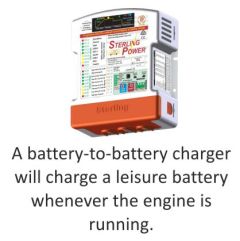
When we talk about battery charging, most people have in their mind a 230V battery charger that plugs into the mains. Using one of these while the vehicle is stationary is easy but what about when the vehicle or boat is on the move? For several years, RoadPro has supplied and installed “battery-to-battery chargers” or “DC-DC chargers”. These work in exactly the same way as mains chargers but take their power from the engine’s alternator via the starter battery.
You may wonder why a battery-to-battery charger is needed when most motorhomes and caravans come fitted with some means of charging the leisure battery when they’re moving. The reality is that the systems used by most manufacturers are – to say the least – basic. And, for anyone who’s serious about staying “off-grid” they can be completely useless. All the battery-to-battery chargers supplied by RoadPro are multi-stage chargers and will charge leisure batteries in the correct way whenever the engine’s running. Even if the vehicle is parked up, running the engine for a few minutes can put enough energy into the battery to provide all the power needed for several hours of wild camping. As with mains chargers, there are different models with different features and output ratings.
RoadPro stocks battery-to-battery chargers from CTEK, NDS, Sterling Power and Votronic. They are all “smart” and they all work efficiently to maintain your batteries correctly.
Charging a battery from a solar panel:
Keeping a battery charged up using a solar panel sounds like a great idea but can actually do more harm than good by overcharging the battery. Some batteries are 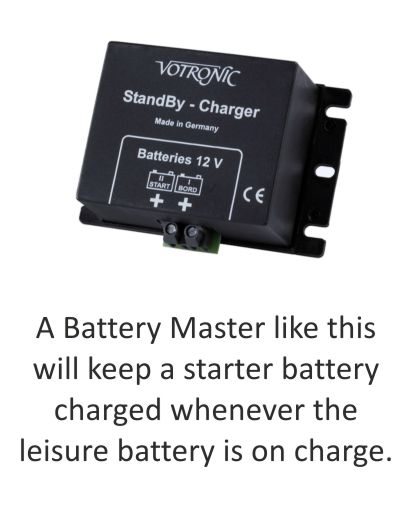 more susceptible to overcharging than others but even good quality batteries can be damaged if they weren’t designed to be on constant charge. The solar panel’s regulator will also affect the way the battery is charged.
more susceptible to overcharging than others but even good quality batteries can be damaged if they weren’t designed to be on constant charge. The solar panel’s regulator will also affect the way the battery is charged.
Keeping a starter battery charged:
Starter batteries are designed to be charged by an engine’s alternator and, because they usually have a fairly easy life, can last for many years. If not used though, they will self-discharge and, for this reason, it’s a good idea to check them on a regular basis and charge them if necessary. Alternatively, fit a stand-by charger – often referred to as a Battery Master. As long as the leisure battery is being charged, either from a solar panel or a 240V charger, the Battery Master will pass current to the starter battery when necessary, ensuring that it doesn’t self-discharge.
Smart Alternators:
The problem of charging leisure batteries whilst driving is even more serious when the vehicle (boats are usually not affected) is equipped with a “smart alternator” and / or regenerative braking. These features have been introduced in order to help vehicles comply with ever tougher regulations concerning fuel efficiency and emission control. Unlike traditional alternators, which maintain a voltage of at least 13.8V whenever the engine’s running, smart alternators are controlled by the vehicle’s ECU (Engine Control Unit) and constantly vary the voltage according to what the ECU thinks is required. To cut a long and complicated story short, the voltage generated by a smart alternator can vary between 12.4V or less and 15.0V or more. At times, the ECU may tell the alternator to stop working altogether.
So the problem with smart alternators is: when the alternator’s output is 12.4V or less, it won’t charge the starter battery and, in turn, the leisure battery. When the output is above 14.7V, AGM and gel batteries can be seriously damaged.
With these voltages, VSRs (Voltage Sensitive Relays) like those often fitted to VW campervans won’t work efficiently either. Neither will battery-to-battery chargers designed to work with traditional alternators. In order to fully charge leisure batteries on motorhomes and caravans where a smart alternator is used, it’s essential to use a charger that’s been specifically designed to work with this new, very clever technology.
The people most affected by smart alternators failing to charge leisure batteries are, of course, motorhomers and caravanners. Reassuringly, the trade organisation the NCC (National Caravan Council) is aware of the situation but they don’t offer any realistic advice on how to deal with the situation. They’ve put out a memo as follows:
“The NCC has been made aware of a potential issue with cars fitted with start / stop technology, smart alternators or regenerative braking systems.
The alternator is switched off periodically during a journey to ensure that the battery is not receiving a charge from both the alternator and the regenerative braking system. When the alternator is in the “off” state then the feed to the refrigerator falls, which can lead to the refrigerator within the caravan being switched off. The refrigerator may not be turned back on when the alternator is reactivated. This can also be the case when the start / stop technology is activated as when the engine is stopped it will turn of the alternator.
There have been reported instances of customers stating that the 12V system to the caravan from the car is not working as the fridge is not staying cold during travelling. This could be caused by the effect stated above.
One solution when a car if fitted with the start / stop technology is to temporally turn off the start / stop technology, if this feature to turn this technology off is fitted to the car.
Actions Required:
Dealers to be aware of this potential effect and to advise customers accordingly.”
The problem here is that most dealers are not only unaware of the problems caused by smart alternators, they don’t have the first idea of what to do about them. Fortunately, some of us do!!
The NCC Battery Verification Scheme:
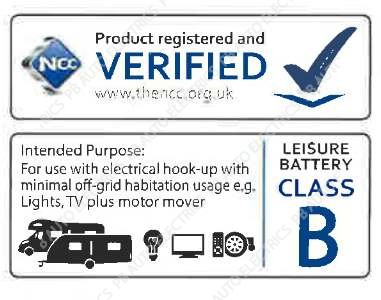 The NCC also understands the confusion amongst caravanners and motorhomers caused by conflicting claims made by battery manufacturers. To try and make things clearer, they operate a scheme to help buyers choose a suitable battery.
The NCC also understands the confusion amongst caravanners and motorhomers caused by conflicting claims made by battery manufacturers. To try and make things clearer, they operate a scheme to help buyers choose a suitable battery.
However, many people who understand batteries feel that the criteria used to classify batteries under this scheme are flawed and that the recommendations given can be misleading. Other people say that it’s better than nothing and it may well be. But, if you’re seriously interested in getting the best battery for your application, you may need to look both at batteries which are not covered by the NCC scheme and at the way the scheme classifies certain batteries as well.
Battery guarantees:
The design and production of batteries is (in Europe and America at least) extremely sophisticated. Brands such as Banner, Bosch, Exide, Green Power, Varta and Trojan have very stringent quality control processes in place. They also test batteries extensively before they’re made available to buy. As such, manufacturing defects are, certainly among the premium brands, very rare.
It’s natural to look for a battery with a good guarantee. But you should always read the small print and this is especially true of batteries. No manufacturer will guarantee their batteries against failure or damage caused by normal wear and tear, lack of maintenance or incorrect charging. As with tyres, a leisure battery’s useful life depends entirely on how it’s used. Use it frequently to power an inverter, don’t bother to check the electrolyte levels and allow it to self-discharge over the winter and a battery can be fit only for scrap within a year or even less.
The simple fact is that, if you buy a battery made by a reputable manufacturer (not a label printer), the chances of a battery failing as a result of faulty design or manufacture is almost zero.
When charging batteries, voltage is (almost) everything. Use too high a voltage and the battery will be damaged: too low and the battery won’t be properly charged and will be damaged. Here are the voltages you should look for when charging batteries.
Voltages shown here are the maximum that should be used during the “bulk” charging phase.
- Wet lead acid: 14.4V (up to 15.8V at low current for reconditioning / de-sulphation mode).
- AGM: 14.7V
- Gel: 14.4V
- LiFePO4: 14.4V or 14.6V (depending on the manufacturer’s recommendations.)
Typical average charging voltages:
|
Battery Type |
Bulk Stage |
Absorption Stage |
Float Stage |
Max. Voltage for Desulphation |
Notes |
|
Wet lead acid |
14.4V |
14.4V |
13.2V |
15.8V |
Current should vary according to voltage. |
|
A.G.M. |
14.7V |
14.7V |
13.5V |
N/A |
Current should vary according to voltage. |
|
Gel |
14.4V |
14.4V |
13.2V |
N/A |
Current should vary according to voltage. |
|
LiFePO4 lithium |
14.6V |
14.6V |
N/A |
N/A |
When battery is full, no maintenance charge is necessary. Refer to manufacturers’ instructions. |
Battery voltages – 12V nominal:
This chart applies to all types of lead-acid battery with zero current flow. It shows typical voltages of lead-acid batteries when they’ve been fully charged and left standing for 2 hours with no charge or discharge applied.
|
State of Charge |
Voltage |
Specific Gravity |
|
100% |
12.7V |
1.265 |
|
75% |
12.4V |
1.225 |
|
50% |
12.2V |
1.190 |
|
25% |
12.0V |
1.155 |
|
Discharged |
11.9V |
1.120 |
For more information on batteries of all kinds, we always recommend visiting Battery University. http://batteryuniversity.com
NOTE: To the best of our knowledge, the information above is accurate. However, we do not assume any liability whatsoever for the accuracy and completeness of the information. If you find any errors, please let us know.
If you want your leisure batteries and your battery charging systems to work as efficiently as possible, get in touch with us.
We recommend the following for use as service / leisure batteries:
- Energy Bull semi-traction batteries from Banner.
- Green Power AGM batteries from NDS.
- EZA lithium power-packs from EZA.
- 3Lion lithium batteries from NDS.
- Epsilon lithium batteries from Super B.
We recommend mains battery chargers from these manufacturers:
- CTEK
- NDS
- Sterling Power
- Votronic
We recommend battery-to-battery chargers from these manufacturers:
- CTEK
- NDS
- Sterling Power
- Votronic
You can see these products and many more on our website: www.roadpro. co.uk
RoadPro Ltd, 7, Stephenson Close, Daventry, Northants, NN11 8RF.
Tel: 01327 312233 E-mail: sales@roadpro.co.uk www.roadpro.co.uk